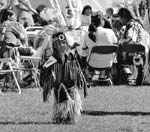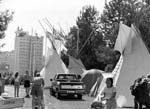|
| |
Native American
|
| |
Songs: of the Powwow
|
EtiquetteIf you are a first time powwow visitor, learn about some basic powwow etiquette on the following pages. It will enhance you appreciation and enjoyment of the powwow.
Showing Respect
Showing Respect Continued
Links Continue your dancing by going to To Sing and Dance, in the Nez Perce module. In the Tutxinmepu Powwow held on the the University of Idaho campus, many of the dancers were Schitsu'umsh and one of the emcees was Cliff SiJohn.
|
|
Chel chs tu's swinsh - "we are going over there to war dance."
The singing, drumming and dancing of the powwow provide opportunities for the Schitsu’umsh to express prayer and give thanks, renew family ties and initiate new friendships, and "just have fun." Held throughout the year, powwows celebrate the gathering of the water potato, the school graduation of the youth, an elder’s birthday, the veterans from the community, a Catholic pilgrimage to the Cataldo Mission, the success of the tribal casino, the ownership of a Lake, and just a "time to gather the families."
|
Cliff SiJohn holds "The Indian Flag," the Eagle Feather staff, during the Powwow celebrating the ownership of Lake Coeur d'Alene and the opening of the new tribal Longhouse. The powwow was held at the Coeur d'Alene Tribal Casino on October 20, 2001. *(512K Viewing Option) (recorded and edited by Rodney Frey, October 2001) |
After years of litigation with the state of Idaho, the U.S. Supreme Court ruled on June 18, 2001 that the Coeur d’Alene Tribe was "entitled to exclusive use, occupancy and right" to the bed and banks of the southern third of Lake Coeur d’Alene. On October 20, 2001 the Schitsu’umsh gathered to celebrate the return of their lake. At sunrise of that day many Schitsu'usmh gathered along the shores of the lake to offer prayer and thanks. Then that evening at the Coeur d’Alene Casino the thanks and celebration were continued with the sharing of a meal, followed with the song and dance of a powwow.
|
Honoring the Youngest tribal member, Isaac Redheart SiJohn, with mother, Leanne SiJohn, during the Lake Celebration Powwow. Drum: Rose Creek Singers, an all Coeur d'Alene women's drum group. *(512K Viewing Option) (recorded and edited by Rodney Frey, October 2001) |
 | | A Young Dancer, August 1995 |
The "powwow" has emerged in the twentieth century as one of the most vital expressions and celebrations of what it means to be Indian and Schitsu'umsh today. Gathering together and dancing in celebration, in thanksgiving, in prayer, in honoring others and in recreation have always been an important aspect of the life of the people. Following the establishment of the Catholic Church, these various dances were either greatly curtained or outright prohibited. After experiencing the devastation of repeated smallpox epidemics, the trauma at the hands of repressive missionaries, army colonels, and government agents, and dislocation from the land itself as a result of the Allotment Act, today it is in the powwow dance arena that a truly Indian "land" is brought forth and traveled. There are few other places untrammeled by the harsh consequences of the suuyapi. While no longer able to ride against the army colonels of the nineteenth century, the powwow "battlefield" offers an opportunity to successfully resist the onslaught of Euro-American culture.
|
|
Ernie Stensgar, Tribal Chairman and Vietnam Veteran, reflects on the importance of patriotism, the American and Eagle Staff Flags, and the warrior society. For the Indian veterans, you can still "see the lumps in their throats and tears in their eyes" when they hear the Honor Song, our national anthem. (interviewed and edited by Rodney Frey, September 2002) |
 | | Intertribal Encampment, August 1995 |
Powwow "land" is literally brought into being, at that very moment and at that very place, as the songs are sung and feet move to the rhythm of the drum beat, and as the eagle feather bustles lift the dancers off the ground and swirl them around. In powwow land, be it under the stars in a brush arbor or under the fluorescent lights in a community center, school gymnasium or even a casino, the hearts of young and old are renewed as they are brought into kinship with the heartbeat of the drum. In powwow land the values held dear to one’s family and the unique heritage of one’s people can be celebrated unencumbered. In powwow land sovereignty is fully realized as one is able to rejoice and share what is most cherished and revered - what it means to be Schitsu'umsh.
|
|
Some of the sights and sounds of Intertribal dances, during the Lake Celebration Powwow, held at the Coeur d'Alene Tribal Casino. Among the dancers are Marcy Morris, Jeanne Givens, Leanne and Frenchy SiJohn, and Father Thomas Connelly *
(512K Viewing Option) (recorded and edited by Rodney Frey, October 2001) |
*To view and appreciate the fast motion of powwow dancing, a 512K option has been added for these powwow sequences. Because of some visual distortion, 28K access is not available on this page.
© Coeur d'Alene Tribe 2002
< previous |
next >
|
|
|












